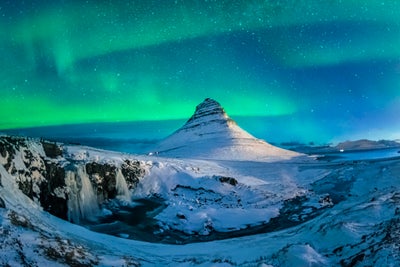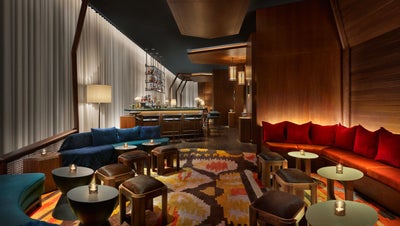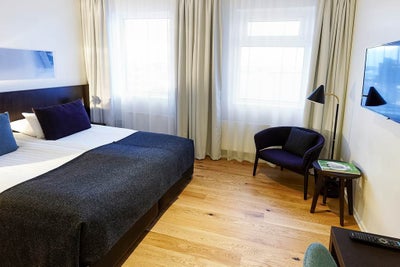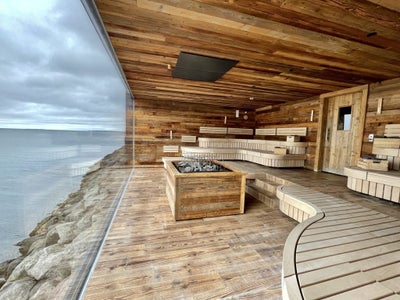
When you think of Iceland, the first thing that may come to mind is volcanoes, geysers and glaciers, and your first instinct is pretty much correct. But there’s much more to this Nordic island country, also known as the Land of Fire and Ice. Over the last decade, Iceland has become one of Europe’s “it” destinations as Black travelers become increasingly exposed to the celestial — and highly Instagrammable — landscapes of ancient glaciers, natural hot springs and black sand beaches. It’s safe to say, Iceland has some of the most spectacular natural scenery you will see anywhere in the world, and should rank high on anyone’s travel bucket list.
Way back in March of 2021 (which seems like a lifetime ago in pandemic years), Iceland became the first country in Europe to reopen its borders to Americans, and since then, it has become a must visit destination for Black travelers and explorers alike. If you’ve been thinking about a visit, and don’t know where to start, here are a few tips for planning your Iceland escape.
When to go.
Many people consider the summer months of June to August the best time to visit Iceland — especially if you’d like to avoid the freezing cold. This is when the weather is warmest, but it’s important to emphasize that it doesn’t get hot like you’d expect in summer. In Reykjavik average temperatures in July range from 48 – 57ºF and it can be colder, depending on which part of the country you visit. If you’d like to get the true “winter wonderland” or cold weather destination experience, it’s important to note that some attractions, like Iceland’s famous hot springs, are open all year, while natural phenomena like the northern lights and midnight sun are best viewed during specific months. March and September are the best months for seeing the Northern Lights, specifically.
Getting there.
With affordable flights to and from major U.S. cities, including Boston, Chicago, Denver, New York City, and more, Icelandair is a popular airline for travelers hoping to explore Iceland, either on its own, or during a quick stopover en route to their final destination. The Icelandair Stopover makes it easy to include Iceland on transatlantic trips, allowing travelers to make a one- to seven-day stop in Iceland at no additional airfare, which quite frankly, it’s all that is needed to check out the destination’s famous geysers, waterfalls, and volcanos or visit the Sky Lagoon before continuing on to your next destination.
There are five classes of service on international Icelandair flights: Economy Light, Economy Standard, Economy Flex, Saga Premium, and Saga Premium Flex. Flex, unsurprisingly, is the most flexible fare class allowing you the ability to cancel or change your flight or get a refund for partly used tickets, but don’t get your hopes up for the typical international lie-flat seats in Saga. If anything, it’s comparable to a domestic first-class experience, not a transatlantic service. Though, whatever class you choose, it’s a solid product and all fares include complimentary in-flight entertainment, blankets and pillows, and nonalcoholic beverages.
Where to stay if you’re seeking luxury.
The Reykjavik EDITION has set a new standard as the Icelandic capital’s first truly luxury hotel experience, since opening late last year. Designed in partnership with local architecture firm, T.ark and New York-based studio, Roman and Williams with guidance of ISC (Ian Schrager Company) design, subtly capturing the spirit of Reykjavik while avoiding the clichés and remaining firmly rooted in the EDITION brand’s strong sense of refined sophistication and style.
Where to stay if you’re on a budget.
Fosshotel Reykjavík, Iceland’s largest hotel, stands prominently in Reykjavík’s business district, only a short walk from the main shopping area. The hotel is a generous 4 stars, and provides guests with access to a restaurant and fitness center on-site, but expect no frills or thrills. Don’t leave before paying a visit to the famous Hallgrímskirkja, the largest church in Reykjavík, Iceland, which is only minutes away.
What to do.
Iceland’s Northern Lights season from late August to mid-April is not only the best time to hunt for sightings of this jaw-dropping, natural phenomenon, it’s also an ideal time to soak in the warm, soothing waters of the Blue Lagoon, made even more marvelous when it’s snowing outside! This plus the festivals, cultural events and lively nightlife of Reykjavík give you all the ingredients for a fantastic getaway.
Not to mention, options ranging from the well-known Blue Lagoon to the newly opened Sky Lagoon to the lesser-known Secret Lagoon, the hardest thing about this deal will be choosing where you will relax.
Source: Read Full Article




